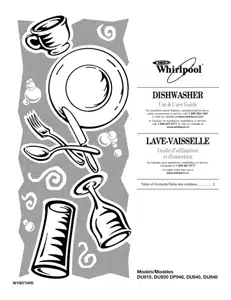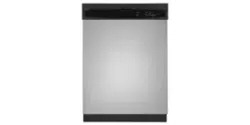Documents: Go to download!
User Manual
- Owner's manual - (English, French)
- Installation Instruction - (English)

Use & Care Guide Dishwasher for Whirlpool DU930PWSS0
Table of Contents
- Dishwasher Safety
- Parts And Features
- Control Panels
- Undercounter Start-Up Guide
- Using Your New Dishwasher
- Stopping Your Dishwasher
- Portable Start-Up Guide
- Using Your New Dishwasher
- Stopping Your Dishwasher
- Connecting The Dishwasher
- Connecting The Faucet Adapter
- Connecting To Water And Electrical Supply
- Using The Faucet
- Disconnecting The Dishwasher
- Dishwasher Loading
- Loading Suggestions
- Loading Top Rack
- Loading Bottom Rack
- Loading Silverware Basket
- Dishwasher Use
- Detergent Dispenser
- Rinse Aid Dispenser
- Dishwasher Efficiency Tips
- Cycle Selection Charts
- Canceling A Cycle
- Changing A Cycle Or Setting
- Adding Items During A Cycle
- Option Selections
- Cycle Status Indicators
- Drying System
- Overfill Protection Float
- Washing Special Items
- Dishwasher Care
- Cleaning
- Drain Air Gap
- Storing
- Troubleshooting
- Assistance Or Service
- Warranty
Using Your New Dishwasher
A power supply of 120 volts, 60 Hz AC, 15 or 20 amps, is required.
- Plug into a grounded 3 prong outlet.
- Scrape large food soil and hard items (toothpicks or bones) from dishes.
- Properly load the dishwasher. Make sure nothing keeps the spray arm(s) from spinning freely.
- Add detergent and check the rinse aid dispenser. Add rinse aid if needed.
- Push door firmly closed. The door latches automatically. Run hot water at the sink where you will connect dishwasher until water is hot. Turn off the water and hook the dishwasher to the faucet. Turn on the hot water.
- Press the desired cycle and option selections
- Press START/RESUME.
Connecting To Water And Electrical Supply
- Run water at the faucet until it is hot. Turn off the water.
- Pull the hoses out of their storage compartment on the back of the dishwasher. NOTE: Make sure the hoses are not kinked or twisted. Kinked hoses reduce washing performance.
- Pull down on the locking collar while lifting the hose connector onto the faucet adapter.
- When the connector snaps into place, release the locking collar.
- Turn the hot water on slowly until it is all the way on.
- Plug into a grounded 3 prong outlet.
Loading Suggestions
- Remove leftover food, bones, toothpicks and other hard items from the dishes. It is not necessary to rinse the dishes before putting them into the dishwasher. The wash module removes food particles from the water. The module contains a chopping device which will reduce the size of food items. NOTE: If hard items such as fruit seeds, nuts, and eggshells enter the wash module, you might hear chopping, grinding, crunching, or buzzing sounds. These sounds are normal when hard items enter the module. To avoid damage to the dishwasher, do not let metallic items (such as pot handle screws) get into the wash module.
- It is important for the water spray to reach all soiled surfaces.
- Load dishes so they are not stacked or overlapping, if possible. For best drying, water must be able to drain from all surfaces. Make sure pot lids and handles, pizza pans, cookie sheets, etc., do not interfere with the spray arm rotation.
- Run a rinse cycle to keep dishes moist if you do not plan to wash them soon. Foods such as eggs, rice, pasta, spinach, and cooked cereals may be hard to remove if they are left to dry over a period of time.
Additional efficiency tips
- To save water and energy and time, do not rinse dishes before putting them into the dishwasher. Use a low energy, quick, or short cycle whenever possible. These cycles use less hot water and energy than a normal cycle.
- Use a delay feature (on some models) to run your dishwasher during off-peak hours. Local utilities recommend avoiding heavy usage of energy at certain times of day.
- During the summer, run your dishwasher at night. This reduces daytime heat buildup in the kitchen.
- Use the energy-saving dry option whenever possible. Allow longer drying times (overnight) when using these options. Use a rinse aid to improve drying.
- Use cycles or options that add extra heat to the wash or rinse portion of the cycle only when needed.
- Run your dishwasher with full loads. Run a rinse cycle after meals until the dishwasher is full. If your home is equipped with a water softener, you may want to avoid starting the dishwasher during the regeneration of the softener, since this may contribute to poor wash performance.
Dishwasher Care
Cleaning the exterior
- In most cases, regular use of a soft, damp cloth or sponge and a mild detergent is all that is necessary to keep the outside of your dishwasher looking nice and clean. If your dishwasher has a stainless steel exterior, a stainless steel cleaner is recommended.
Cleaning the interior
- Hard water minerals can cause a white film to build up on the inside surfaces, especially just beneath the door area. Do not clean the dishwasher interior until it has cooled. You may want to wear rubber gloves. Do not use any type of cleanser other than dishwasher detergent because it may cause foaming or sudsing.
- To clean interior Make a paste with powdered dishwasher detergent on a damp sponge and clean OR Use liquid automatic dishwasher detergent and clean with a damp sponge.
Drain air gap
- Clean the drain air gap periodically to ensure proper drainage of your dishwasher. Follow the cleaning instructions provided by the manufacturer. With most types, you lift off the chrome cover. Unscrew the plastic cap. Then check for any soil buildup. Clean if necessary.
Storing
- Storing for the summer: Protect your dishwasher during the summer months by turning off the water supply and power supply to the dishwasher.
- Winterizing your dishwasher: Protect your dishwasher and home against water damage due to freezing water lines. If your dishwasher is left in a seasonal dwelling or could be exposed to near freezing temperatures, have your dishwasher winterized by authorized service personnel.
See other models: SF367LXSS0 WRT1L1TZYW00 GD5NVAXSY01 WDF310PAAS2 WTW8040DW0

